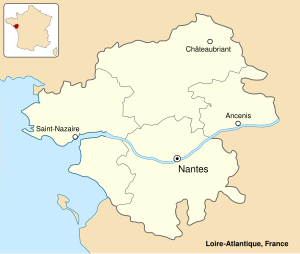Operation Chariot
| St Nazaire Raid Operation Chariot |
|||||||
|---|---|---|---|---|---|---|---|
| Part of the North West Europe Campaign of World War II | |||||||
 St Nazaire on the Loire estuary |
|||||||
|
|||||||
| Belligerents | |||||||
|
|
|
||||||
| Commanders and leaders | |||||||
|
|
|
||||||
| Units involved | |||||||
|
Royal Navy HMS Campbeltown HMS Tynedale HMS Atherstone HMS Sturgeon Motor Gun Boat 314 Motor Torpedo Boat 74 28th Motor Launch flotilla 7th Motor Launch flotilla 20th Motor Launch flotilla British Army No. 2 Commando Selected troops from the Special Service Brigade Royal Air Force No. 51 Squadron RAF No. 58 Squadron RAF No. 77 Squadron RAF No. 103 Squadron RAF No. 150 Squadron RAF |
German Navy 22nd Naval Flak Brigade 280th Naval Artillery Battalion 6th U-boat flotilla 7th U-boat flotilla 16th Minesweeper flotilla 42nd Minesweeper flotilla Torpedo boat Jaguar armed trawler Sperrbrecher 137 Harbour Defence Companies German Army 333rd Infantry Division |
||||||
| Strength | |||||||
| 346 Royal Navy 265 Commandos |
5,000 troops | ||||||
| Casualties and losses | |||||||
| HMS Campbeltown 169 dead * 215 prisoners of war * 1 Motor Gun Boat 1 Motor Torpedo Boat 13 Motor Launches 1 Armstrong Whitworth Whitley 1 Bristol Beaufighter |
Normandie dock 360 dead ^ 2 Junkers 88 2 Tankers 2 Tugs |
||||||
| * Does not include aircraft crews ^ Includes civilians on board HMS Campbeltown when she exploded. ^ The numbers of German troops killed during the raid are not known. |
|||||||
British victory
The St Nazaire Raid or Operation Chariot was a successful British amphibious attack on the heavily defended Normandie dry dock at St Nazaire in German-occupied France during the Second World War. The operation was undertaken by the Royal Navy and British Commandos under the auspices of Combined Operations Headquarters on 28 March 1942. St Nazaire was targeted because the loss of its dry dock would force any large German warship in need of repairs, such as the Bismarck's sister ship Tirpitz, to return to home waters via either the English Channel or the GIUK gap, both of which were heavily defended by British units including the Royal Navy's Home Fleet, rather than having a haven available on the Atlantic coast in Nazi-occupied France.
The obsolete destroyer HMS Campbeltown, accompanied by 18 smaller craft, crossed the English Channel to the Atlantic coast of France and was rammed into the Normandie dock gates. The ship had been packed with delayed-action explosives, well hidden within a steel and concrete case, that detonated later that day, putting the dock out of service for the remainder of the war and up to five years after.
A force of commandos landed to destroy machinery and other structures. Heavy German gunfire sank, set ablaze, or immobilised virtually all the small craft intended to transport the commandos back to England; the commandos had to fight their way out through the town to try to escape overland. Almost all were forced to surrender when their ammunition was expended and they were surrounded and captured by the Wehrmacht defending Saint-Nazaire.
After the raid, 228 men of the force of 611 returned to Britain; 169 were killed and 215 became prisoners of war. German casualties were over 360 dead, some killed after the raid when Campbeltown exploded. To recognise their bravery, 89 decorations were awarded to members of the raiding party, including five Victoria Crosses. After the war, St Nazaire was one of 38 battle honours awarded to the Commandos; the operation has since become known as The Greatest Raid of All within military circles.
...
Wikipedia
